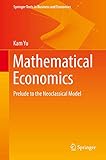Mathematical Economics [electronic resource] : Prelude to the Neoclassical Model / by Kam Yu.
Material type: TextSeries: Springer Texts in Business and EconomicsPublisher: Cham : Springer International Publishing : Imprint: Springer, 2019Edition: 1st ed. 2019Description: XIII, 214 p. 26 illus., 18 illus. in color. online resourceContent type: text Media type: computer Carrier type: online resourceISBN: 9783030272890Subject(s): Game theory | Economic theory | Microeconomics | Macroeconomics | Game Theory, Economics, Social and Behav. Sciences | Economic Theory/Quantitative Economics/Mathematical Methods | Microeconomics | Macroeconomics/Monetary Economics//Financial Economics | Game Theory, Economics, Social and Behav. SciencesAdditional physical formats: Printed edition:: No title; Printed edition:: No title; Printed edition:: No titleDDC classification: 519 | 519 LOC classification: HB144QA269-272HB144QA269-272Online resources: Click here to access online
TextSeries: Springer Texts in Business and EconomicsPublisher: Cham : Springer International Publishing : Imprint: Springer, 2019Edition: 1st ed. 2019Description: XIII, 214 p. 26 illus., 18 illus. in color. online resourceContent type: text Media type: computer Carrier type: online resourceISBN: 9783030272890Subject(s): Game theory | Economic theory | Microeconomics | Macroeconomics | Game Theory, Economics, Social and Behav. Sciences | Economic Theory/Quantitative Economics/Mathematical Methods | Microeconomics | Macroeconomics/Monetary Economics//Financial Economics | Game Theory, Economics, Social and Behav. SciencesAdditional physical formats: Printed edition:: No title; Printed edition:: No title; Printed edition:: No titleDDC classification: 519 | 519 LOC classification: HB144QA269-272HB144QA269-272Online resources: Click here to access online Chapter 1. Logic and Proof -- Chapter 2. Sets and Relations -- Chapter 3. Basic Topology -- Chapter 4. Linear Algebra -- Chapter 5. Vector Calculus -- Chapter 6. Convex Analysis -- Chapter 7. Optimization -- Chapter 8. Probability -- Chapter 9. Dynamic Modeling.
This textbook provides a one-semester introduction to mathematical economics for first year graduate and senior undergraduate students. Intended to fill the gap between typical liberal arts curriculum and the rigorous mathematical modeling of graduate study in economics, this text provides a concise introduction to the mathematics needed for core microeconomics, macroeconomics, and econometrics courses. Chapters 1 through 5 builds students’ skills in formal proof, axiomatic treatment of linear algebra, and elementary vector differentiation. Chapters 6 and 7 present the basic tools needed for microeconomic analysis. Chapter 8 provides a quick introduction to (or review of) probability theory. Chapter 9 introduces dynamic modeling, applicable in advanced macroeconomics courses. The materials assume prerequisites in undergraduate calculus and linear algebra. Each chapter includes in-text exercises and a solutions manual, making this text ideal for self-study.
